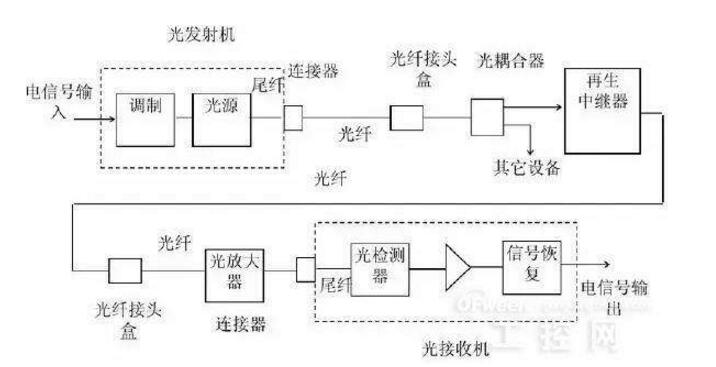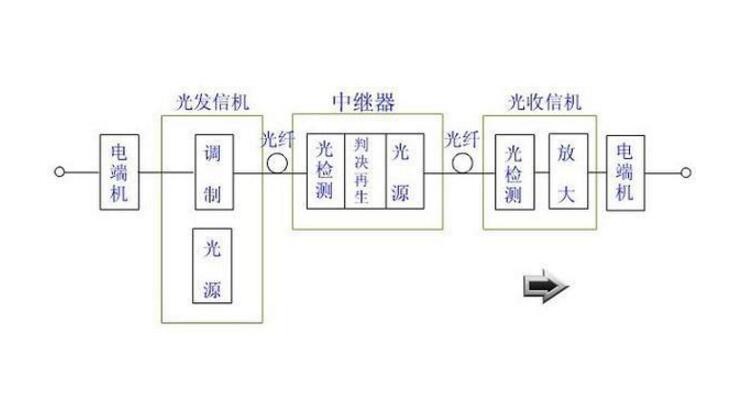The optical fiber communication system is a communication system in which light is used as a carrier, and a very fine optical fiber is used as a transmission medium to transmit information by photoelectric conversion. With the rapid development of the Internet business and the communications industry, informatization has greatly promoted the development of world productivity and human society. As one of the main technical pillars of informatization, optical fiber communication will become the most important strategic industry in the 21st century. 1 The amount of information that can be transmitted in a unit of time is large. In the early 1990s, the practical information rate of fiber-optic communication was 2.488 Gbit/s, that is, a pair of single-mode fibers could simultaneously open 35,000 phones, and it is still developing rapidly; 2 economy. The construction cost of optical fiber communication decreases as the number of uses increases; 3 small size, light weight, construction and maintenance are more convenient; 4Use less metal, anti-electromagnetic interference, strong radiation resistance, good confidentiality, etc. (1) Optical transmitter The optical transmitter is an optical transceiver that realizes electrical/optical conversion. It consists of a light source, a driver and a modulator. Its function is to modulate the light wave from the electric source to the light wave emitted by the light source to become a dimmed wave, and then couple the modulated optical signal to the optical fiber or the optical cable for transmission. The electric terminal is a conventional electronic communication device. (2) Optical receiver The optical receiver is an optical transceiver that realizes optical/electrical conversion. It consists of a photodetector and an optical amplifier. Its function is to convert the optical signal transmitted by the optical fiber or the optical cable into an electrical signal through the optical detector, and then amplify the weak electrical signal to a sufficient level through the amplifying circuit, and send it to the electrical end of the receiving end. (3) Optical fiber or optical cable Optical fibers or optical cables constitute the transmission path of light. Its function is to transmit the dimmed signal sent by the transmitting end to the optical detector of the receiving end after long-distance transmission through the optical fiber or the optical cable to complete the task of transmitting information. (4) Repeater The repeater consists of a photodetector, a light source, and a decision regeneration circuit. It has two functions: one is to compensate for the attenuation of the optical signal transmitted in the fiber; the other is the pulse near-line shaping of the waveform distortion. (5) Passive devices such as fiber connectors and couplers Since the length of the fiber or cable is limited by the fiber drawing process and the cable construction conditions, and the length of the fiber is limited (such as 1 Km). Therefore, there may be a problem that a plurality of optical fibers are connected in one optical fiber line. Therefore, the connection between the optical fibers, the connection and coupling of the optical fibers and the optical transceiver are indispensable for the use of passive components such as optical connectors and couplers. The conventional optical fiber communication system refers to a system in which the transmitting end intensity-modulates the light source, and the receiving end directly detects (IM/DD) the received optical signal by a photodetector, which is also called an intensity-modulated direct-plug-wave optical fiber communication system. It was the actual use of the Lord in the early 1990s. The basic structure is taken as an example of a 2.488 Gbit/s system, as shown in Figure 2. To the left of the figure is a time-division multiplexer at the transmitting end, which combines the input 155 Mbit/s digital signal into a 2.488 Gbit/s signal. The signal directly modulates a distributed feedback laser and transmits the dimmed output to a single mode fiber. The right side of the figure is directly detected by the optical-electric detector, and the digital signal of 2.488 Gbit/s is obtained, and then a set of 155 Mbit/s digital signals is obtained by decomposing the complex. The relay device of the conventional fiber-optic communication system is shown in FIG.
The Privacy Screen Protector can display a black screen directly in front of the screen at an angle greater than 30° to effectively block the sight of people next to it, while achieving a perfect balance between black screen privacy and daytime clarity.
The Screen Protector can protect the edges and gaps of the display so that it can extend to the entire screen surface, thereby achieving maximum coverage without any exposed space.
The Self-Healing Screen Protector can provide the best protection for your phone from drops, bumps, scratches and normal wear and tear. Using an oleophobic waterproof coating can prevent sweat and grease from remaining on your fingerprints, keeping you simple all day long.
The 0.14mm thick Ultra-Thin Protective Film has a "real touch" feel and ensures fast response performance.
If you want to know more about Privacy Screen Protector products, please click the product details to view the parameters, models, pictures, prices and other information about Privacy Screen Protector.
Whether you are a group or an individual, we will try our best to provide you with accurate and comprehensive information about the Privacy Screen Protector!
Anti-peep Screen Protector, Privacy Screen Protector, Anti-spy Screen Protector, Privacy Protective Film, Privacy Hydrogel Film,Anti-peeping Screen Protector Shenzhen Jianjiantong Technology Co., Ltd. , https://www.jjtphonesticker.com


The composition and characteristics of optical fiber communication system _ six development trends of optical fiber communication
1. Introduction to optical fiber communication system